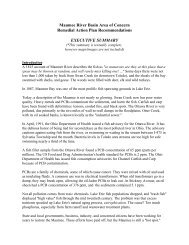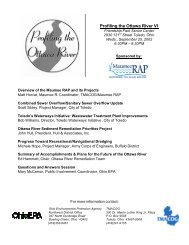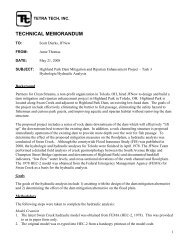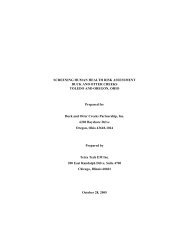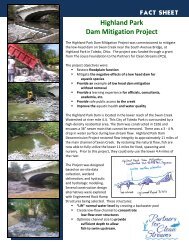Complete report - Partners for Clean Streams
Complete report - Partners for Clean Streams
Complete report - Partners for Clean Streams
You also want an ePaper? Increase the reach of your titles
YUMPU automatically turns print PDFs into web optimized ePapers that Google loves.
(1984)<br />
In 1984, a sampling program was started by the City of Toledo to determine the<br />
leachate quality.<br />
(1987)<br />
In 1987 the Ohio EPA conducted a Preliminary Site Assessment. The shallowest<br />
aquifer was <strong>report</strong>ed to be measuring high levels of biochemical oxygen demand<br />
(BOD) and chemical oxygen demand (COD) and light hydrocarbons.<br />
(1988-present)<br />
Since 1988 the City of Toledo has done numerous investigations at the site. In<br />
addition to previous listings, heavy metals, cyclohexane, and contamination from<br />
domestic waste were noted.<br />
(1996)<br />
In 1996 the site was investigated as a part of the Ohio EPA Maumee Area of Concern<br />
Project Phase II Site Assessments. Analytical results from the soil samples showed<br />
elevated levels of contaminants in the soil and adjacent Duck Creek sediments. From<br />
the available data it was difficult to identify the origin of the contaminants in Duck<br />
Creek, there<strong>for</strong>e this site was recommended <strong>for</strong> further investigation.<br />
Remediation (1975)<br />
In 1975 the City of Toledo contracted to have a leachate collection system installed<br />
and connected to the Wheeling Street sanitary sewer system.<br />
(1991)<br />
Water began to surface at the dump in 1990, presumably from a leak in the City of<br />
Toledo’s high-pressure drinking water line. Holes in the line were found in 1991 and<br />
repaired. This water line will not be used when the city finishes the new line being<br />
constructed in 2001.<br />
(1992)<br />
In August 1992 the extreme southwest corner of the trailer park property was filled<br />
with clean hard fill and covered with two feet of soil material. The fill was placed in an<br />
area adjacent to the playground.<br />
Lead Organization:<br />
City of Toledo<br />
Gulf Oil Refinery and Terminal (2935 Front St., Toledo)<br />
(a.k.a. Chevron)<br />
Site History:<br />
This 228-acre site has a long history of industrial operations. Activities included a dry<br />
dock and iron foundry dating back to 1850. In 1888 the Paragon Refining Company<br />
began operating on the northwest part of this site producing gasoline, fuel oils,<br />
lubricating oils, and wax. Gulf bought the property from Paragon in 1939, modernized<br />
and expanded the refinery, and produced sulfur, propane, automobile fuels, jet fuel,<br />
home heating oil, # 6 oil, and asphalt stock. Portions of the property acquired by Gulf<br />
during this expansion had been used <strong>for</strong> the manufacture of lubricating oils, roofing<br />
and road materials and retail gasoline marketing. Gulf closed the refinery in 1981 and<br />
decommissioned the refinery process equipment in 1984. The following year Gulf and<br />
Chevron merged. Several remaining dilapidated buildings were razed in 1994.<br />
81<br />
Activities and Accomplishments<br />
Issue 2: Landfills, Dumps and<br />
in the Maumee Area of Concern Brownfield Sites



